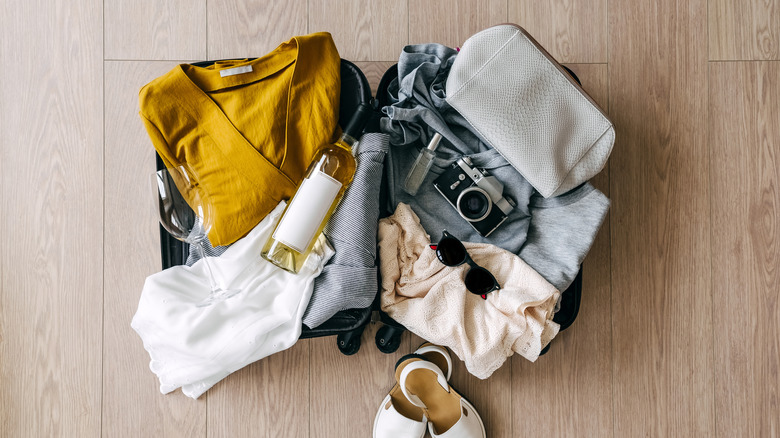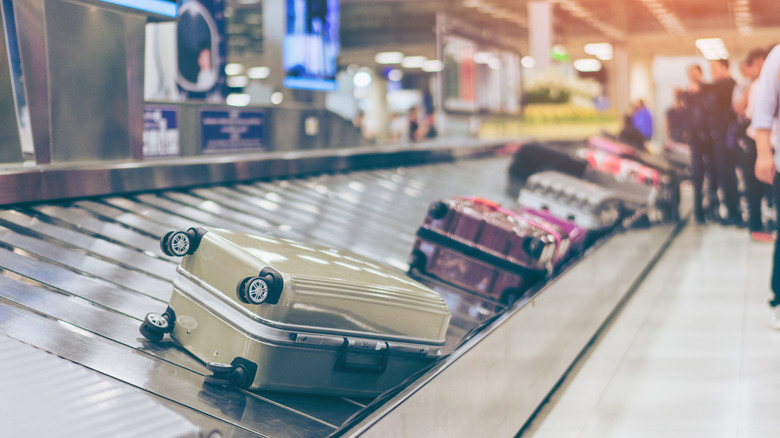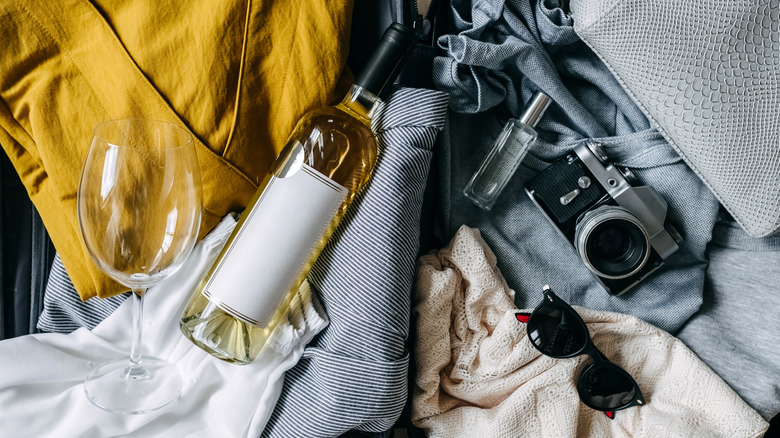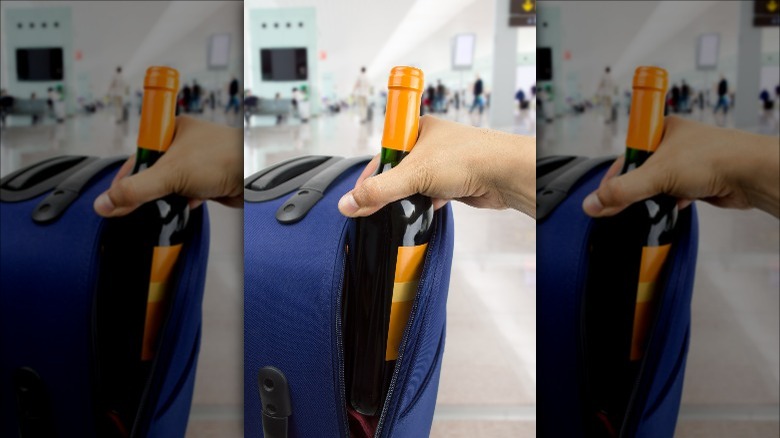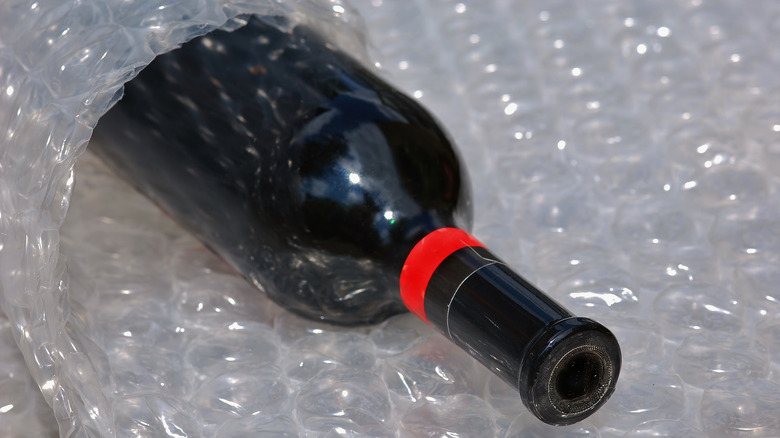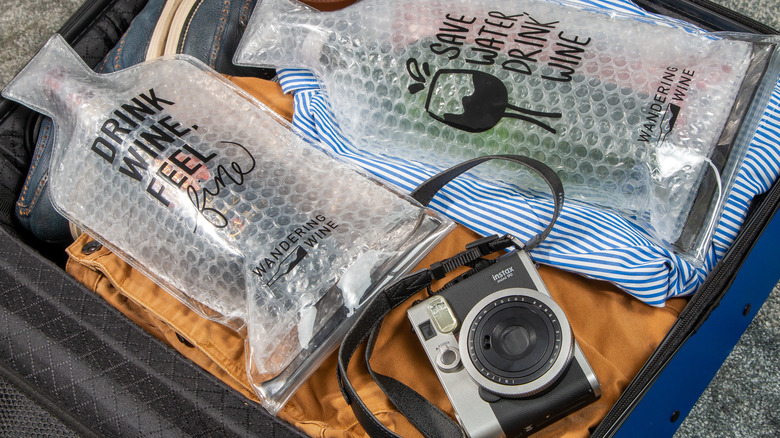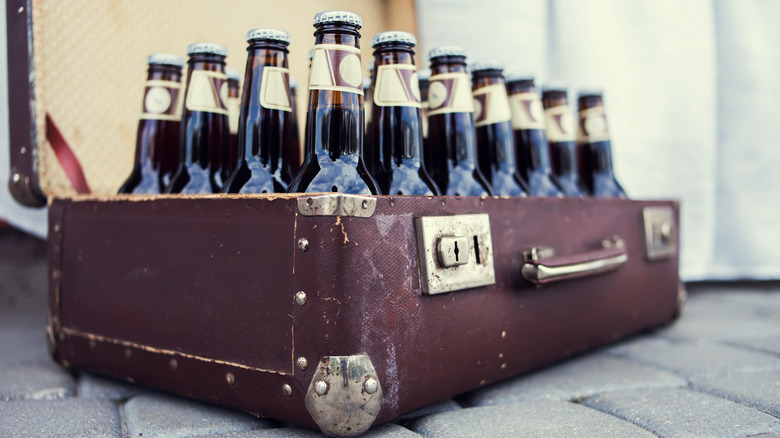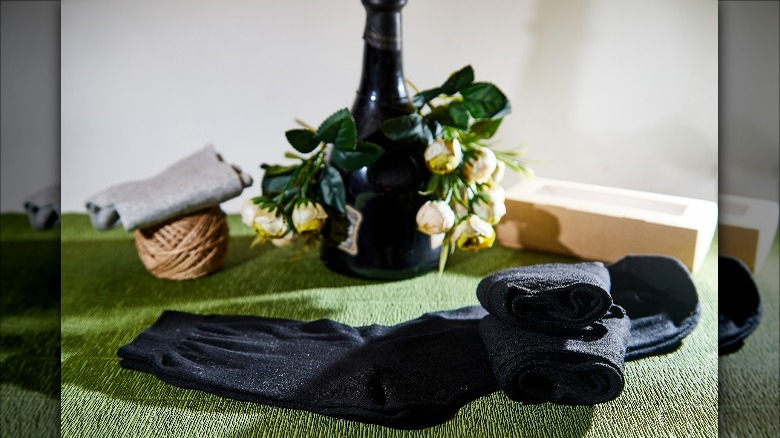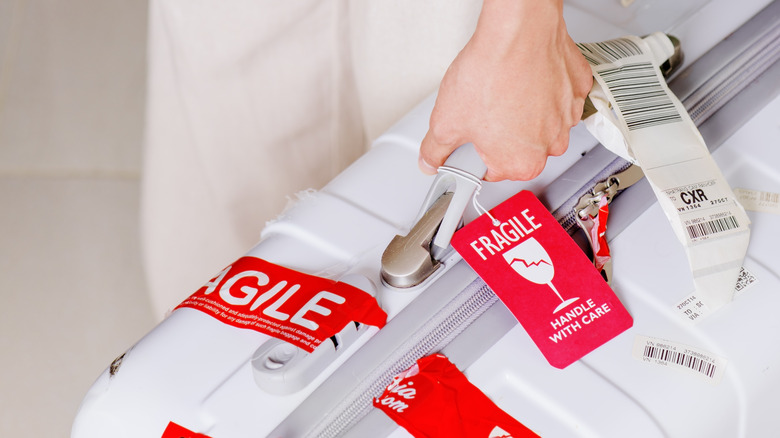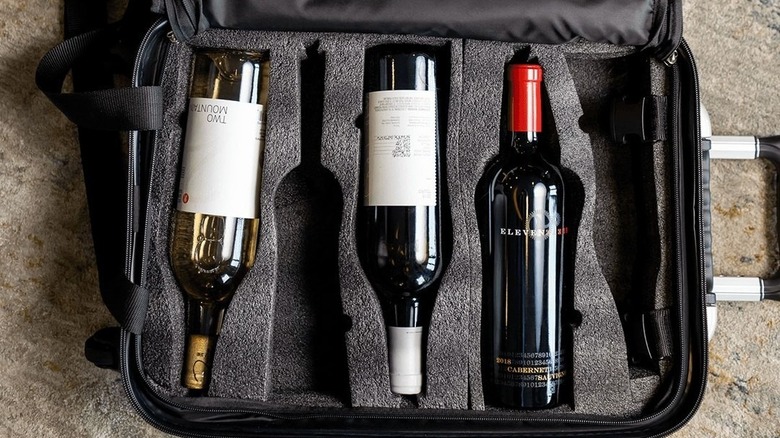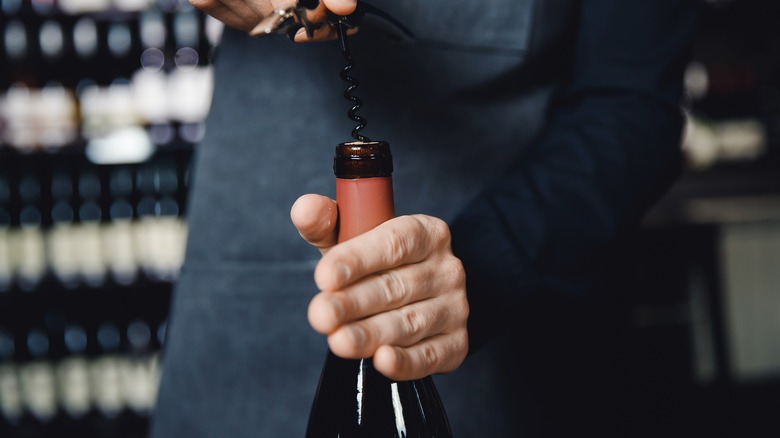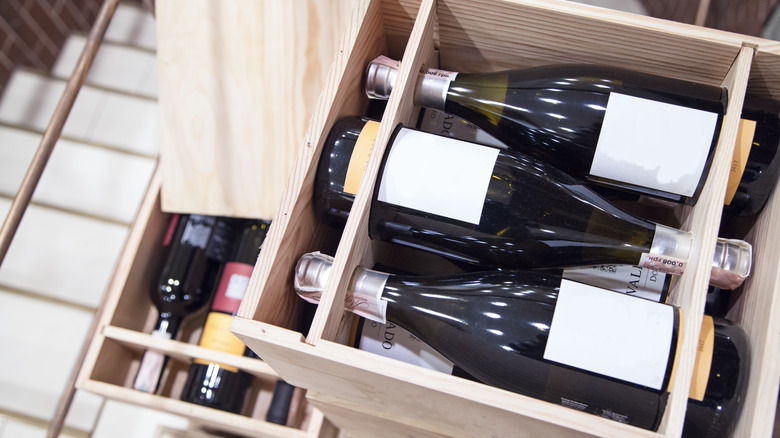How To Pack Beer And Wine In Your Suitcase
If you've ever traveled with a suitcase, chances are you've found yourself in a situation where you're cramming items in, trying to make everything fit. Whether it's leaving for a trip with more than you need or returning home with an extra load, it can be tough to fit all of your belongings. It's one thing to stuff clothes in the extra nooks, but if you've got anything fragile, such as bottles of beer and wine, it poses a few additional risks.
Maybe you've just visited wine country or toured a brewery, or perhaps you're heading home for the holidays and want to bring a few bottles to celebrate. Either way, a lot can go wrong if you aren't careful packing your loot. From holdups at Transportation Security Administration (TSA) checkpoints to a wardrobe stained in red wine, the stakes are high.
That being said, there are a number of factors that will improve your chances of successfully transporting booze in your luggage. From the right packing techniques to specialized accessories (all while avoiding legal issues along the way), we've got the scoop on the best ways to pack wine and beer in your suitcase.
Pack alcohol in your luggage, not your carry on
If you remember traveling by airplane before 2006, then you'll recall a time when there were no regulations regarding the liquid contents of your carry-on bag. Following a 2006 terrorist plot that relied on liquid explosives, the TSA introduced a ban on all liquids in containers greater than 3.4 fluid ounces (via The New York Times). The only exception exists if you purchase bottles at an international airport duty-free store. You certainly can't sip on the booze though; any sign that the bottle has been opened will result in immediate confiscation (via TSA).
Although mini liquor bottles come in at half the permitted volume, you'll be hard-pressed to find a wine or beer bottle under 3.4 ounces. Given that you're probably trying to transport regular-sized bottles, you're going to want to pack them in your checked luggage. Per the Federal Aviation Administration (FAA) there are no limits regarding the volume of beer or wine you can pack. Restrictions begin above 24% ABV, however, standard products (even fortified wine) won't cause any issues.
Use your clothes as a cushion
Before you get fancy and start buying extra wine-packing equipment, it's worth starting with what you already have. Unless you're traveling to or from a hot tropical destination, you're probably bringing some cushiony clothing such as sweaters or jeans. These items make an excellent foundation to protect glass bottles. If you're low on extra options, your bag of dirty laundry can be dismantled, and you could go a step further and nestle smaller bottles directly in with your smelly clothes. (We don't necessarily recommend this if you're bringing wine as a gift.)
Professional packers have a system when it comes to laying out all of their pieces, and there's even a science behind how to arrange items. Mechanical and civil engineering professor Jose Andrade explains that there's a branch of physics that looks at the way motion, pressure, and force work in tandem, and it applies to packing (via The Points Guy). By surrounding your precious bottles with cushiony fabrics, impact is distributed more evenly. Rolled-up socks are a great option, and Andrade indicates that synthetic fabrics are better suited for the task than clothes made from cotton.
Protect the bottles with careful placement
The most important factor when packing bottles of booze is to ensure that they don't have to endure great amounts of pressure, even if they are tossed around. Properly placing the items in your bag will improve your chances of making it to your destination with your wine and beer intact.
According to Laura McHolm, an expert packer for household moves, the lower middle area of your bag is the ideal spot to stash bottles (via Real Simple). This gives you space to surround them with cushiony items to handle any impact. Similarly, avoid laying bottles in the corners of your bag as these spots tend to receive the most shock.
A good tip to prevent them from shifting out of place is to place your shoes or other rigid articles along the sides of your suitcase. Although your instinct might be to squeeze bottles into tight spaces so that they can't budge, Steven Freifeld, the owner of a shipping company that focuses on fragile items, explains that the key is to pack densely but evenly (via The Points Guy). Too much loose space in your luggage and things will move around; conversely, containing your fragile bottles too tightly places unnecessary pressure that can ultimately cause them to break if your bag is impacted externally.
Wrap the bottle with bubble wrap
An inexpensive way to protect any bottles you picked up at a wine tasting or are bringing home for the holidays is to use bubble wrap. The fun-to-pop material is designed to protect breakables thanks to tiny air pockets that provide cushioning and minimize shocks. Be sure to wrap the bubbles such that they touch the glass bottles without the risk of popping from external impacts.
Granted, if you're trying to bring bottles back home, it may be trickier to get your hands on the stuff if you're in an unfamiliar location. (Where do you buy bubble wrap if there's no local Target?) Your best chance of sourcing the cushiony material is to inquire directly at the place where you've picked up your bottles. Wineries or breweries often have packaging materials on-site since many regularly ship their products. Styrofoam blocks are also increasingly used to package fragile bottles for cross-country shipping.
If you're sitting at home trying to figure out how to bring a few bottles of your mom's favorite wine for Thanksgiving, start by visiting your local post office or shipping company. FedEx or UPS outlets are generally well equipped with the necessary materials to safely pack breakable objects. Or else, head to your nearest big box store or simply open your browser and visit Amazon.
Buy a bottle protector that's made for travel
If you're packing wine or beer in your suitcase as a one-off occurrence, being resourceful with your dirty laundry and wooly sweaters is fine. However, if you can't imagine traveling without your favorite beer or wine in tow, or if your gift of choice when visiting friends and family is a bottle of wine, you'll want to take it up a notch. There are plenty of products on the market with the sole intention of protecting your bottles of booze.
Most models are sleeves made from a cushiony material to protect glass bottles. Think of them as bubble wrap socks except they aren't smelly and the bubbles don't pop. We recommend Monkkino's inflatable sleeves which you can flatten when not in use or JetBag's leak-proof pockets that can absorb an entire bottle of wine in the worst-case scenario. With features such as shock absorption, handles, and zip lock seals, these reusable bags are designed with wine and beer lovers in mind. You'll also find significantly sturdier (but bulkier) options such as the Bottle Bully, a hard cylindrical case with an inflatable lining.
If you're hesitating about the extra cost, consider the priceless benefit of arriving at your location stress-free with your bottles intact. Not to mention, wine sleeves are available for all budgets, from under a dollar a piece to $5 or $10 a unit.
Do not pack bottles next to each other
This might sound like a no-brainer but placing two or more hard fragile items next to each other is a recipe for disaster. Any impact to your bag will result in a far greater chance of the bottles breaking, versus if they were packed with cushiony items on either side to absorb some of the shock. If you're using protective wine sleeves, then you have a bit more leeway in terms of the placement of your bottles, but it's not a foolproof plan.
That being said, if you have the space to keep your precious wine and beer separate, you're best off avoiding potential collisions between the bottles. Also, consider the fact that a single impact to your suitcase could potentially result in two broken bottles if they're located next to each other. If space is at a premium or you're traveling with lots of bottles and minimal packing accessories, mesh sleeves offer some protection while taking up almost no additional volume. On the other hand, if you've carefully distributed them throughout your bag with cushiony possessions shielding them from each other, your chances of finding all your bottles intact at arrival are greater.
Consider using socks or plastic bags
If you're going the basic route and using your clothes as protective shields for whatever bottles of booze you're packing, it's worth implementing a few backup measures. In case items move around in your bag as it's tossed from one pile to another before landing on the carousel, it's not impossible for something fragile to break. Of course, if you've carefully followed our packing tips and considered the physics of force on the bottles, you should be safe.
Nonetheless, there are still some unknowns to contend with, so it's best to be prepared. On the off chance that a bottle shatters, it's already disappointing to lose the contents. While it might just be a liquor store bottle you're bringing home for the holidays, it could also be something special you picked up from a winery overseas.
To avoid the additional dismay of finding all of your clothes soaked in wine, wrap each bottle in a plastic bag. While you're at it, double-wrap them and be sure to tie a knot to provide the best seal possible. Oh, and check for holes. If you're traveling with long wooly socks, use them as an immediate cushion around the glass bottles. Follow up by arranging the bottles such that they are surrounded by clothes on either side.
Apply a fragile sticker to your luggage
Airline counters provide more than a spot to drop off your luggage and ask for a free upgrade. If you've ever traveled with a suitcase that exceeds the weight limits, you'll have received a tag labeling it as heavy. On that same note, you can ask for a sticker that indicates the contents of your bag are fragile. Depending on the airline, it might include "handle with care" on the label.
You'd think that was sufficient for your bag to be treated with the utmost care, but as it turns out, it won't guarantee your bottles arrive safely. According to an airport crew member who spoke with Condé Nast Traveler, employees try to keep an eye out for stickers but if a bag has old tags and labels on it, then they might disregard them all. Emirates 247 interviewed other baggage handlers and airport staff, who clarify that the lack of attention isn't malicious, but merely a case of needing to get luggage in and out of the plane as quickly as possible ... which often involves throwing them.
If you really want the fragile label to mean anything, you're best off getting multiple stickers to plaster all over the bag. Ultimately, hard case bags simply fare better, especially if they appear to be carrying something fragile or important like a musical instrument.
Pack alcohol in hard suitcases if possible
Given what we've gathered from airport staff and the fact that soft bags are referred to as "wet noodles" among other names (via Condé Nast Traveler), the number one way to boost your chances of success is to pack your booze in a hard-shell suitcase. The outer casing will absorb some of the shock from impacts, making it a bit safer for your bottles of wine and beer.
If you're in the business of moving alcohol (because it's your preferred souvenir or gift, or even for official purposes), then your best bet is to invest in a specialized bag. Depending on the model you choose, you might need to pack an additional suitcase for your actual clothes. That being said, we're talking about suitcases that can safely store a dozen standard bottles of wine.
Among the industry favorites, Wine Enthusiast makes the Vino-Voyage 2.0, which is marketed as a TSA-approved wine suitcase to carry six bottles. The interior consists of slots shaped like wine bottles lined with foam padding for ultimate protection. The bag is obviously hard-shelled with reinforced corners to guarantee its structural integrity. Meanwhile, VinGardeValise comes in multiple sizes with options from five to 12 bottles, as well as modifiable foam inserts so you can carry a combination of standard and smaller bottles too. For a heavy-duty option that is unlikely to be thrown around, CasePro offers hard temperature-controlled wine carriers that can hold up to 24 bottles.
Never travel with open bottles of alcohol
Aside from all of the logistics of actually packing your bottles of booze, there are a number of laws surrounding transporting them by air. If you're traveling to another country, you'll have to familiarize yourself with the specific rules about bringing alcohol across their borders. As mentioned, the FAA doesn't impose restrictions on the number of bottles you can transport, as long as the alcohol level is below 24%.
However, the FAA regulation specifies that the containers must be sealed with no signs of tampering. Since the bottles need to be in your checked luggage, the issue isn't related to drinking from your stash (another FAA no-no on airplanes). Given that the permitted volumes become more limited when the ABV is superior to 24%, it's likely a way to ensure bottles aren't filled with other contents. And for your own sake, packing an open bottle of beer or wine is an added risk you're probably best avoiding if you value having clean undamaged clothes.
Consider shipping bottles instead
If you've read through all of our recommendations and are increasingly panicked about the responsibility you hold in ensuring your bottles make it to their destination safely, you can always leave it up to professionals. For a bottle or two, the hassle of dealing with a shipping company might be overkill. However, if you've just finished a two-week holiday touring wineries in Tuscany, sending a case of wine back home is a task best suited for professionals.
U.S. Customs and Border Protection reports that individuals can import an unlimited amount of alcohol into the country — with the caveat that large volumes might be flagged if you haven't received a pre-approval. That being said, state laws have their own restrictions, so it's necessary to be informed to prevent your alcohol from being held by authorities.
You'll have to pay some duty on the booze, but due to their low alcohol content, beer and wine should only add up to a couple of dollars per bottle. The IRS also charges additional taxes, but the paperwork should all be streamlined if you're dealing with a company or through a winery. And if you're hoping to bring your parents a bottle from your favorite local winery for the holidays, you might be better off having it sent directly from the source.
